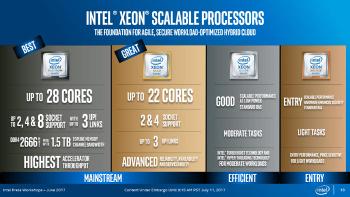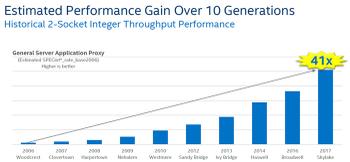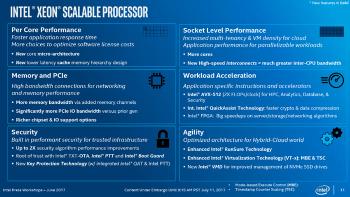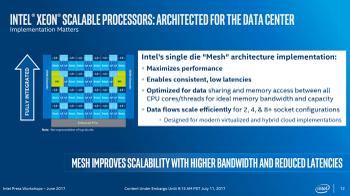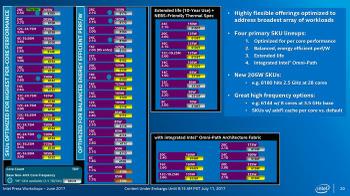Intel has launched a massive range of new Xeon processors based upon the new Skylake SP core. There are more than 50 new processors in all, spread across the new Bronze, Silver, Gold, and Platinum ranges - plus 7 new chipsets.
Intel claims that customers will benefit from an approx 1.65x performance uplift over previous gen Xeon processors and when applied to deep learning and inference the new processors do even better with a 2.2x uplift. In addition Intel claims that the new Xeons offer "the industry’s highest energy efficiency". Performance gains of the Intel Xeon Scalable processors are largely down to the new cores and the new Intel Mesh Architecture. The gains are the greatest in a decade, trumpets Intel.
Scalable Platform explained
Intel Xeon SP chips boast up to 28 cores and 56 threads. Furthermore, systems can host up to 6TB of RAM (4-socket systems) and scale to support 2-socket through 8-socket systems. Thus users can create a Xeon SP system for entry level workloads all the way to modern HPC modelling and simulation, machine learning, HPC and digital content creation tasks.
As mentioned above, a significant change in the Xeon SP chips comes from the Mesh Architecture. Previously Intel used a ring design with cores arranged in one or two loops and thus core communication had to go around the ring, over potentially a large number of hops. The new Mesh design arranges the cores, plus memory controllers and I/O interfaces in a 2D grid (such as 4x4, 4x6, or 6x6 depending upon core count).
The sheer range and segmentation of Intel Xeon processors launched contrasts starkly with AMD's Epyc server offerings. Intel's precious metal themed range sub-divisions with various core counts, clock speeds, turbo speeds, cache sizes, I/O support and memory support makes the mind boggle. Interestingly the most powerful new processor launched by Intel, the 8180M with 28 cores, 56 threads, a base clock speed of 2.5GHz, turbo to 3.8GHz, and 1.5TB memory support costs over $13,000.
click to zoom



